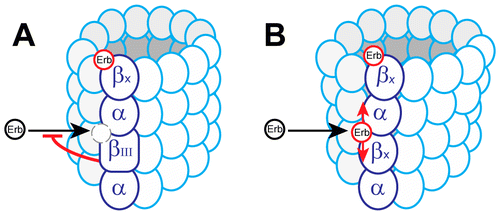The taccalonolides and paclitaxel cause distinct effects on microtubule dynamics and aster formation
Mitotic asters induced by paclitaxel or the taccalonolides. The mitotic asters in HeLa cells treated with vehicle, 12 nM paclitaxel, 5 μM taccalonolide A or 20 nM taccalonolide AJ, the minimum concentrations that caused maximum mitotic accumulation, were visualized by indirect immunofluorescence for β-tubulin (top). DNA was visualized by DAPI staining (middle) and merged images are shown with microtubules in green and DNA in blue (bottom).
April L Risinger,1,2 Stephen M Riffle,3 Manu Lopus,3,4 Mary A Jordan,3 Leslie Wilson,3 and Susan L Mooberry1,2
1. Department of Pharmacology, University of Texas Health Science Center at San Antonio, San Antonio, TX 78229, USA
2. Cancer Therapy & Research Center, University of Texas Health Science Center at San Antonio, San Antonio, TX 78229, USA
3. Department of Molecular, Cellular and Developmental Biology, University of California, Santa Barbara, CA 93106, USA
4. UM-DAE Centre for Excellence in Basic Sciences, University of Mumbai Campus, Kalina, Santacruz East, Mumbai 400098, India
Background
Microtubule stabilizers suppress microtubule dynamics and, at the lowest antiproliferative concentrations, disrupt the function of mitotic spindles, leading to mitotic arrest and apoptosis. At slightly higher concentrations, these agents cause the formation of multiple mitotic asters with distinct morphologies elicited by different microtubule stabilizers.
Results
We tested the hypothesis that two classes of microtubule stabilizing drugs, the taxanes and the taccalonolides, cause the formation of distinct aster structures due, in part, to differential effects on microtubule dynamics. Paclitaxel and the taccalonolides suppressed the dynamics of microtubules formed from purified tubulin as well as in live cells. Both agents suppressed microtubule dynamic instability, with the taccalonolides having a more pronounced inhibition of microtubule catastrophe, suggesting that they stabilize the plus ends of microtubules more effectively than paclitaxel. Live cell microscopy was also used to evaluate the formation and resolution of asters after drug treatment. While each drug had similar effects on initial formation, substantial differences were observed in aster resolution. Paclitaxel-induced asters often coalesced over time resulting in fewer, larger asters whereas numerous compact asters persisted once they were formed in the presence of the taccalonolides.
Conclusions
We conclude that the increased resistance of microtubule plus ends to catastrophe may play a role in the observed inability of taccalonolide-induced asters to coalesce during mitosis, giving rise to the distinct morphologies observed after exposure to these agents.


